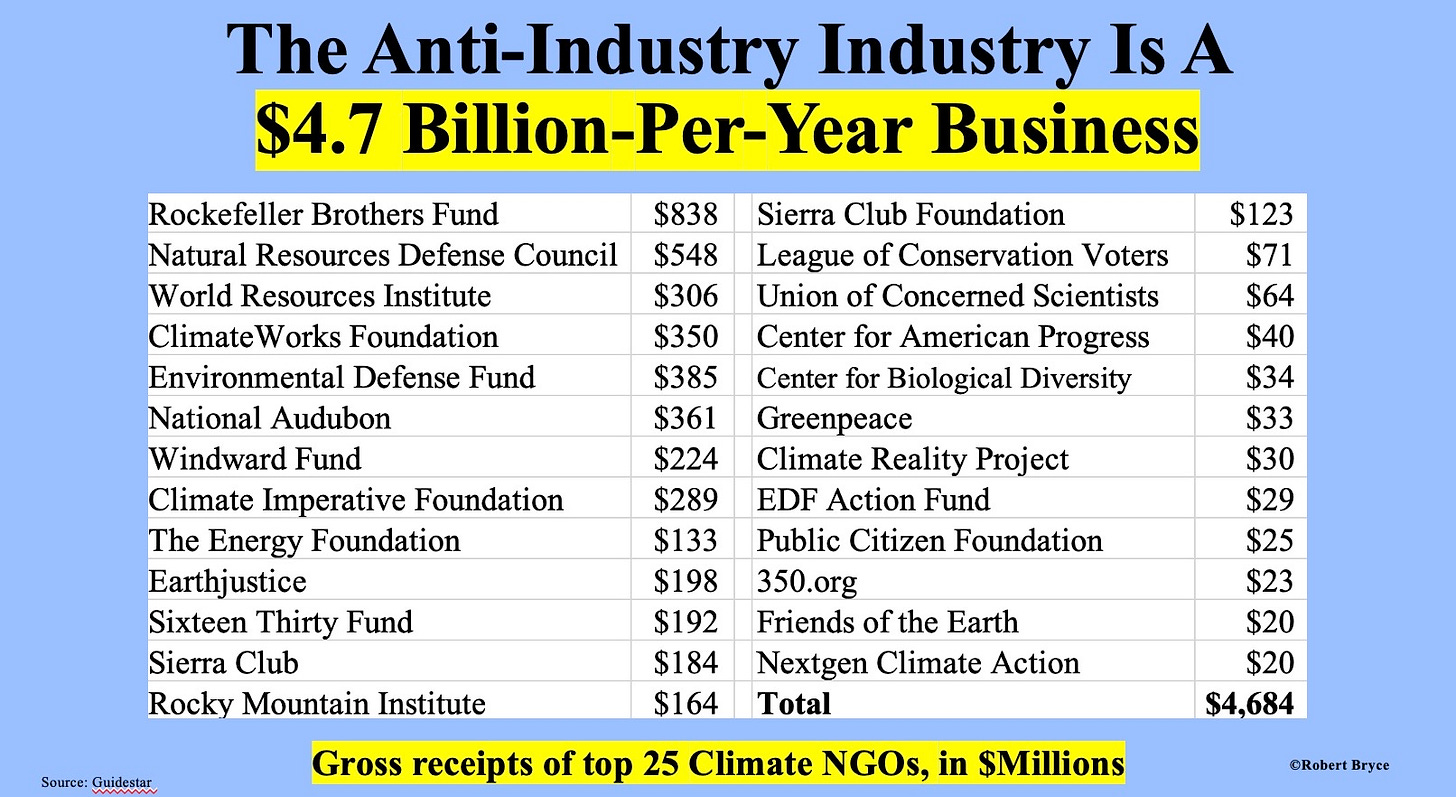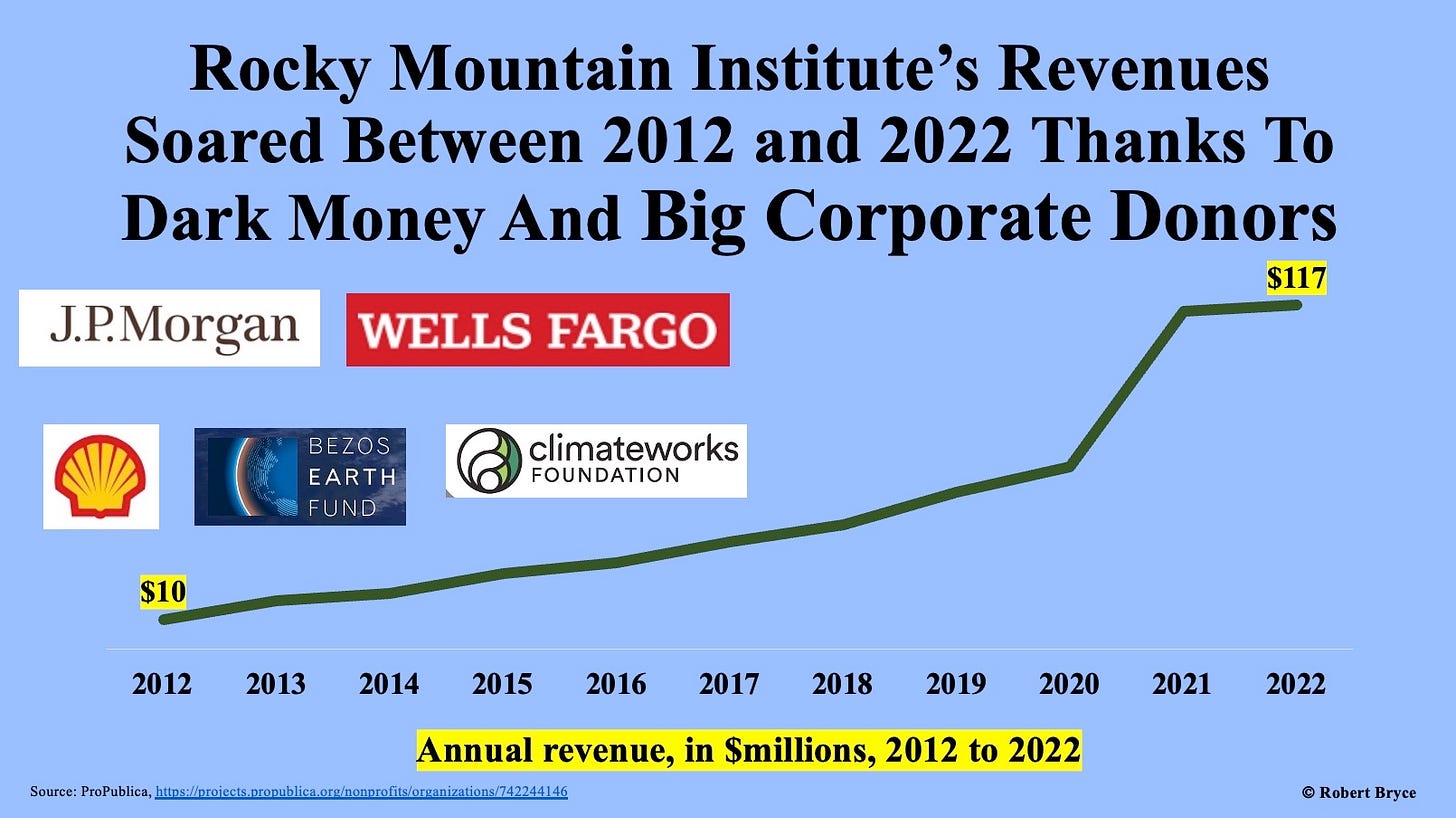
ENB Pub Note: This is an outstanding article from Robert Bryce’s Substack. I highly recommend subscribing and following Robert. He will be on the Conversations In Energy with Stu Turley next month to go over this and some other key issues.
Environmentalism in America is dead. It has been replaced by climatism and renewable energy fetishism.
The movement birthed by Rachel Carson’s Silent Spring in the early 1960s and Earth Day in the 1970s — a movement that once aimed to protect landscapes, wildlands, whales, and wildlife — has morphed into the NGO-corporate-industrial-climate complex. Rather than preserve wildlands and wildlife, today’s “green” NGOs have devolved into a sprawling network of nonprofit and for-profit groups aligned with big corporations, big banks, and big law firms. In the name of climate change, these NGOs want to pave vast swaths of America’s countryside with oceans of solar panels and forests of 600-foot-high wind turbines. They are also promoting the industrialization of our oceans, a move that could put hundreds of massive offshore wind turbines in the middle of some of our best fisheries and right atop known habitat of the critically endangered North Atlantic Right Whale.
The simplest way to understand how climatism and renewable energy fetishism have swamped concerns about conservation and wildlife protection is to follow the money. Over the past decade or so, the business of climate activism has become just that — a business. As I reported last year in “The Anti-Industry Industry,” the top 25 climate nonprofits are spending some $4.5 billion per year. As seen below, the gross receipts of the top 25 climate-focused NGOs now total about $4.7 billion per year.

These groups — which are uniformly opposed to both nuclear energy and hydrocarbons — have budgets that dwarf those of pro-nuclear and pro-hydrocarbon outfits like the Nuclear Energy Institute, which, according to the latest figures from Guidestar, has gross receipts of $194 million, and the American Petroleum Institute which has gross receipts of $254 million. (Unless otherwise noted, the NGO figures are from Guidestar, which defines gross receipts as a “gross figure that does not subtract rental expenses, costs, sales expenses, direct expenses, and costs of goods sold.” Also note that in many cases, Guidestar’s gross receipts figure doesn’t match the revenue that the NGOs are reporting on their Form 990s.)
To understand the staggering amount of money being spent by the NGO-corporate-industrial-climate complex, look at the Rocky Mountain Institute, the Colorado-based group founded by Amory Lovins, the college dropout who, for nearly 50 years, has been the leading cheerleader for the “soft” energy path of wind, solar, biofuels, and energy efficiency. (Click here for my 2007 article on Lovins.) Between 2012 and 2022, according to ProPublica, Rocky Mountain Institute’s annual budget skyrocketed, going from $10 million to $117 million.

Indeed, the group provides a prime example of how corporate cash and dark money are fueling the growth of the NGO-corporate-industrial-climate complex. Among its biggest donors are corporations that are profiting from the alt-energy craze. Last year, Wells Fargo, a mega-bank that is among the world’s biggest providers of tax-equity financing for alt-energy projects, gave Rocky Mountain Institute at least $1 million. On its website, Wells Fargo says it is “one of the most active tax-equity investors in the nation’s renewable energy sector, financing projects in 38 states.” In 2021, the bank bragged that it had surpassed “$10 billion in tax-equity investments in the wind, solar, and fuel cell industries. Wells Fargo has invested in more than 500 projects, helping to finance 12% of all wind and solar energy capacity in the U.S. over the past 10 years.”
Another mega-bank giving big bucks to RMI is J.P. Morgan Chase, which gave at least $500,000 in 2023. I took a deep dive into alt-energy finance last year in “Jamie Dimon’s Climate Corporatism.” I explained:
About half of all the tax equity finance deals in the country (worth about $10 billion per year) are being done by just two big banks, J.P. Morgan and Bank of America. The two outfits have the resources to handle the tax credits that are generated by renewable projects and pair those “tax subsidies” (the term used by Norton Rose Fulbright) with the capital financing needed to get the projects built.
Last year, Rocky Mountain Institute got a similar amount from European oil giant Shell PLC, which has been active in both onshore and offshore wind. In addition, last year, the Rocky Mountain Institute published a report in partnership with the Bezos Earth Fund, which claimed, “the fossil fuel era is over.” The Bezos Earth Fund, of course, gets its cash from Amazon zillionaire Jeff Bezos. Last year, Bezos’s group gave Rocky Mountain Institute at least $1 million. In addition, Amazon, which claims to be “the world’s largest corporate purchaser of renewable energy,” is a significant donor and was the sole funder of a report published earlier this year by RMI that promotes increased use of — what else? — solar, wind, and batteries.
RMI also got at least $1 million from two NGOs — ClimateWorks Foundation and the Climate Imperative Foundation — which funnel massive amounts of dark money to climate activist groups. San Francisco-based ClimateWorks has gross receipts of $350 million. ClimateWorks lists about two dozen major funders on its website, including the Bezos Earth Fund, Bloomberg Philanthropies, the Ford Foundation, and the Hewlett Foundation. However, the group’s tax filings show that it gets most of its funding from individuals, none of whom are disclosed on its Form 990. In 2022, ClimateWorks got $128 million from an unnamed individual, $45 million from another individual, and $24 million from another. In all, ClimateWorks collected about $277 million — or roughly 84% of its funding — from a handful of unnamed oligarchs. Who are they? ClimateWorks doesn’t say, but notes that it has “several funders that [sic] prefer to remain anonymous.”
Climate Imperative, also based in San Francisco, doesn’t reveal the identities of its funders, nor does it publish the names of all the activist groups it funds. But it is giving staggering sums of money to climate groups. Climate Imperative’s gross receipts total $289 million. The group’s goals include the “rapid scaling of renewable energy, widespread electrification of buildings and transportation, [and] stopping the expansion of fossil fuel infrastructure.”
Elite academics produce studies that provide ammunition to the NGO-corporate-industrial-climate complex. Last year, in an article published in the left-wing magazine Mother Jones, Jesse Jenkins, an assistant professor of mechanical and aerospace engineering at Princeton University, claimed, “We now have the potential to rebuild a better America.”

Doing so, he explained, will require a much larger electric grid with “up to 75,000 miles of new high-voltage transmission lines by 2035.” That’s enough, he noted, to “circle the Earth three times.” He continued, saying the U.S. will also need utility-scale solar projects covering “an area the size of Massachusetts, Rhode Island, and Connecticut combined, and wind farms that span an area equal to that of Illinois, Indiana, Ohio, Kentucky, and Tennessee.”
Jenkins claims we can have a “better America” by covering eight states with solar panels (most of which are made with Chinese components) and endless forests of massive, noisy, bird-and-bat-killing wind turbines. Put another way, the Princeton net-zero plan would require paving some 239,000 square miles (620,000 square kilometers) of land with solar and wind projects, and that doesn’t include the territory needed for all the high-voltage transmission lines that would be needed!
On its face, the notion is absurd.
Nevertheless, the scheme, published in 2020 and known as the Net-Zero America study, got positive coverage in major media outlets, including the New York Times.

Despite the cartoonish amount of land and raw materials it would require, the Princeton net-zero plan shows how renewable energy fetishism dominates today’s energy policy discussions. Nearly every large climate-focused NGO in America claims our economy must soon be fueled solely by solar, wind, and batteries, with no hydrocarbons or nuclear allowed. But those claims ignore the raging land-use conflicts happening across America — and in numerous countries around the world — as rural communities fight back against the encroachment of Big Wind and Big Solar.
Perhaps the most striking example of the environmental betrayal now underway is the climate activists’ support for installing hundreds, or even thousands, of offshore wind platforms on the Eastern Seaboard, smack in the middle of the North Atlantic Right Whale’s habitat. Last month, I published this video showing habitat maps and the areas proposed for wind development.
Among the climate groups shilling for offshore wind is the Center for American Progress (gross receipts: $40 million), founded by John Podesta, who now serves as President Biden’s advisor on “clean energy innovation and implementation.” Last year, Podesta’s group published an article claiming “oil money” was pushing “misinformation” about offshore wind.
Rather than defend whales, the group claimed the offshore wind sector is “a major jobs creator and an important tool in reducing greenhouse gas emissions.” Who funds the Center for American Progress? Among its $1 million funders are big foundations, including Bloomberg Philanthropies, the Gates Foundation, and the Chan Zuckerberg Initiative. Two familiar names, Climate Imperative and ClimateWorks, each gave the group up to $500,000 last year. On the corporate side, the group got up to $500,000 from Amazon.com and Microsoft.
Now, let’s look at the Sierra Club (gross receipts: $184 million), a group whose mission statement states that it aims “To explore, enjoy, and protect the wild places of the earth.”
Alas, protecting wild places doesn’t include our oceans. In March, Ben Jealous, the executive director of the Sierra Club, defended the offshore wind industry, claiming that “fossil fuel industry front groups” were trying to make “whales and other marine species a cultural wedge issue.” He also claimed that “disruptions in the whales’ feeding patterns, water salinity, and currents are likely the result of climate change,” adding that “climate change perhaps is the largest overriding problem, and our transition away from fossil fuels to clean energy the solution.”Just for a moment, imagine what Podesta’s group, or the Sierra Club, would be saying if those scalawags from the oil industry were planning to put hundreds of offshore platforms in the middle of whale habitat. The wailing and gnashing of teeth would be audible from here to Montauk. Those NGOs would be running endless articles about the dangers facing the Right Whale — of which there are only about 360 individuals left, including fewer than 70 “reproductively active females.” But since the industry aiming to industrialize vast swaths of our oceans has been branded as “clean,” the response from the Sierra Clubbers has been, well, crickets.
If the climate groups are seriously concerned about reducing emissions, they would be clamoring for the increased use of nuclear energy, the safest form of zero-carbon electricity generation. It also has the smallest environmental footprint. But the Sierra Club, in its own words, “remains unequivocally opposed to nuclear energy.” Furthermore, leaders at the Natural Resources Defense Council (gross receipts: $548 million) cheered in 2021 when the Indian Point nuclear plant in New York was prematurely shuttered. What does NRDC claim we can use to replace nuclear? Offshore wind, of course.
The punchline here is obvious: it’s time to discard the shopworn label of “environmentalism.” The NGOs discussed above, and others like them, are not environmental groups. Their response to the specter of catastrophic climate change will require wrecking our rural landscapes, the killing of untold numbers of bats, birds, and insects, and industrializing our oceans with large-scale alt-energy projects.
America needs a new generation of activists who want to spare nature, wildlife, and marine mammals by utilizing high-density, low-emission energy sources like natural gas and nuclear energy. We need advocates and academics who will push for a weather-resilient electric grid, not a weather-dependent one. Above all, we need true conservationists who promote a realistic view of our energy and power systems. That view will include a positive view of our place on this planet, a view that seeks to conserve natural places, not to pave them.
Source: Robertbryce.substack.com



